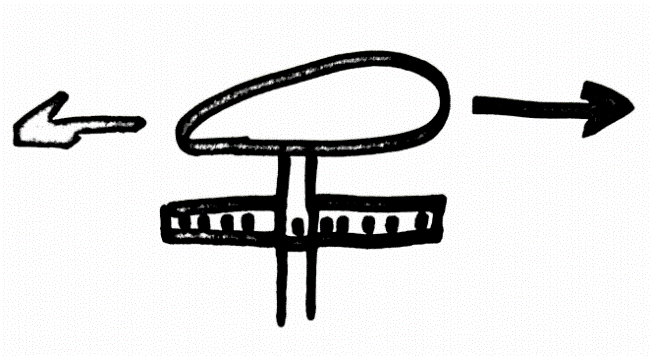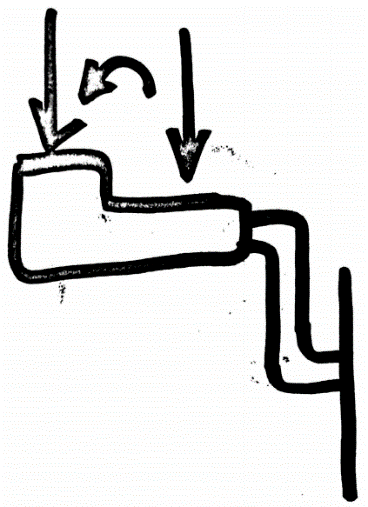Crankset Slider
The crankset slider is a crank based concept that consists of a crank with a channel machined out of it. A tension spring is attached at the top of the channel and to the pedal holder, which is the drawing on the right side of figure 19 belowbelow. In the 3 to 6 o’clock position of the pedal stroke the spring elongates, thus increasing the length of the crank. The crank length will be shortened at the top of the pedal stroke, which will allow the knee angle to open up and ease the pain in the knee. Advantages of this design is that it maximizes torque in the pedal stroke, low weight, keeps the knee at an angle greater than 90o, and is retrofittable. Disadvantages of this design is that this design may be difficult to manufacture, due to the possibility of welding aluminum.

Pedal Slider
The pedal slider design is similar to crankset slider except that it is mounted to a standard set of cranks. The design is a hollow rectangular box with an open side. A tension spring is attached to the top of the inside of the box and to the top of the pedal holder. This design screws into normally where the pedal would go and the straps on the top of it will wrap around the cranks to hold the pedal slider in place. Same as the crankset slider, the pedal slider's spring in the 3 to 6 o'clock position of the pedal stroke elongates and in the 12 o'clock position the spring will be retracted thus making the crank arm feel shorter and increasing the knee angle. Advantages of this design is that it is low weight, can be placed on any crankset with the same threading, and keeps the knee angle greater than 90o. Disadvantages of this design is there is a safety and durability issue with the spring and widens the rider's stance on the bicycle.

Translating Cranks
The translating cranks is a crank based design. The design uses two vertical parallel bars that attach to the crank arms and to the pedal bar which is seen above the crank arm in Figure 21 below. The two bars are allowed to move freely in either the left or right direction. In the lower half or 3 to 9 o'clock position of the pedal stroke the cranks will be in the extended position, illustrated by the drawing on top in the figure. This position will extend the crank length through part of the downward stroke, increasing the torque output. In the upper half of the pedal stroke or 9 to 3 o'clock position of the cranks, the cranks will be in the lower position shown in the figure. This will shorten the crank length at the top of the pedal stroke allowing for a greater knee angle. Advantages of this design is that it is retrofittable, able to maximize torque output in the pedal stroke, and keep the knee angle greater than 90o. The disadvantages of this design is that the pedal bar moving freely may be difficult to adjust to and the vertical bars may break from impact forces of a crash.

Four Chainrings
The four chainrings design is the concept of creating a greater range of gears available to the rider. The gears would range from an extremely tall gear (55T or 54T) that can be used for fast descents or sprint finishes in a race to a small gear (30T or 32T) for steep or long climbs. The team recommends that this design is paired with short crank arms in order to keep the knee angle greater than 90o. The advantages of this design is that the largest chairing would maximize torque output, increase the range of gears usable by the rider, and the design is durable. The disadvantages of the four chainrings is that there are no currently no commercially available cranksets, shifters, or front derailleurs that are designed to accommodate four chainrings on a bicycle.

Q-Rings / Elliptical Chainrings
Q-rings are commercially available elliptical chainrings, they are mentioned previously in section 3.2.6 of this report. The team recommends that this design is paired with short crank arms in order to keep the knee angle greater than 90o. These chainrings allow the user to produce more torque through the power phase of the pedal stroke and Q-rings reduce the force on the knee in the dead spots of the pedal, which is located at the top and bottom of the pedal stroke. The advantages of this design is that it is lightweight, durable, safe, retrofittable, and helps to produce maximal torque. The disadvantages of this design is that Q-rings drop chains more frequently than standard round chainrings, crank arm length is nonadjustable, and elliptical chainrings may take time to get accustomed to.
Gear Ratios
Adjusting the gear ratios on the client’s bicycle is the simplest solution. This design involves making the chainrings larger and/or making the cassette teeth smaller in order to produce more toque through the drivetrain of the bicycle. The advantages of this design is that it is safe, durable, retrofittable, low weight, inexpensive, and simple. The disadvantages of this design is that the knee angle may be less that 90o and the torque increase in the system may be marginal.
Manually Adjustable Pedals
An issue with the current design of a shorter crank arm length is that it limits torque. This limited torque creates a designed disadvantage when in competitive applications. As a modification of this design, the user can adjust the crank arm length on an as-needed basis. By releasing a locking mechanism connecting the pedal to the crank arm, the user can move the pedal to several positions along the crank arm while riding. This results in a shorter effective crank arm length. In application, the rider can shorten the effective crank arm length while at cruising speeds, and lengthen it when extra torque is needed for added acceleration.

CVT (Continuously Variable Transmission)
As currently designed, a CVT transmission maximizes the torque transferred from an engine to the wheels. This is done by having a large number of gear sets that seamlessly change gearing based on the input torque and rpm. These transmissions are frequently used in small (under 50cc) scooter applications. To explore the maximization of the available torque a user can utilize, the implementation of a CVT transmission may be advantageous. In application the user would not need to shift the bicycle, the gearing ratio delivering maximum torque would already be selected. This coupled with a shorter crank arm would provide the user with the maximum torque with minimal bending of the knee.

Translating Seat
While current designs raise the seat to minimize knee bending, this causes discomfort and possible injury for the user. A different approach would be to translate the seat horizontally. This would change the angle the knees would bend without adding the unwanted discomfort. This design would be achieved by adding a horizontal post onto the base of the seat. A metal pin would be inserted to lock the seat into the horizontal post.

Modified Pedal Shape
In an attempt to create an adjustable crank arm length, a modification of the pedal can be utilized. In this design, the pedal would be modified to have multiple “steps” of height along its width. While this would significantly increase the width of the pedal, this would achieve an inexpensive and effective way to adjust the angle of the users’ knees.

